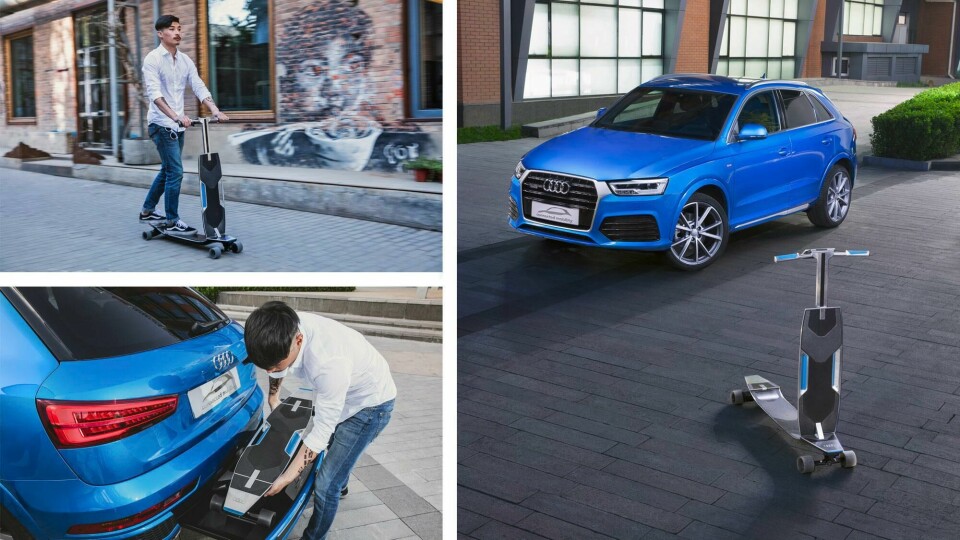
Covering the last mile: a history of mixed-mode concepts
Exploring the ultimate concept car accessory
A neatly folded Brompton bicycle will fit in the back of almost any car, allowing a commuter to park away from gridlocked city streets and complete the ‘last mile’ of their journey on two wheels.
But this simple, mixed-mode approach can be improved upon, of course. Pedalling can be sweaty work, while a bike in a boot is not exactly neatly integrated. So it’s no surprise that car designers have dreamed up many clever dual-mode concepts over the years. The results have often been intriguing.
Peugeot 3008 with e-Bike or e-Kick

When Peugeot’s latest 3008 goes on sale at the end of this year, the compact SUV will be offered with a couple of unusual optional extras. Customers will be able to order a folding electric bicycle or an electric scooter. Each has been designed to slot in the back and recharge on the move.
A cycle maker itself, Peugeot has built its own e-Bike but partnered with Swiss company Micro Mobility to create the e-Kick scooter. It weighs 8.5kg, features a lithium-ion battery in the footplate and a rear hub motor with regenerative braking. Top speed is 15mph and range is 7.5 miles. It’s unclear how much effort the rider will need to contribute to reach these figures.
Honda Motocompo

The original dual-mode product is surely Honda’s Motocompo, a 50cc motorcycle designed to squeeze into the back of a 1981 Honda City hatchback. Sold as an optional extra, the Motocompo collapsed into a suitcase-sized block.
Honda’s tiny bike was not a runaway success, however, perhaps because at 45kg it was difficult to heave into the boot. About 53,000 examples were sold in Japan and today are much loved collectors’ items.
Audi Connected Mobility concept

Audi’s Connected Mobility concept was revealed in April at the 2016 Beijing show, developed by Audi’s local R&D team. It’s a seemingly standard Q3 with a tray slotted into the rear bumper, housing an electric longboard.
The alloy and carbon board recharges while stowed and converts into skateboard or kick-scooter formats. Using real-time traffic data, the Q3’s navigation system will recommend where to park and switch modes, according to Audi, syncing with the user’s smartphone to continue guidance.
Smart FourJoy

Smart’s FourJoy concept, shown in Frankfurt in 2013, lacked doors or a roof but did feature overhead sockets for twin electric longboards. The rear hatch provided dedicated storage for helmets plus a video camera. “This enables longboard riding to be filmed and subsequently shared with friends on social networks,” Smart noted.
The FourJoy previewed the current ForFour city car, which sadly doesn’t yet feature skateboards as an option.
BMW i8 Spyder concept

For the 2012 Beijing show BMW’s plug-in hybrid i8 lost a roof and gained a pair of electric scooters, housed above the engine beneath a glass cover. Echoing the i8 Spyder, the scooters make extensive use of carbon fibre.
In March the i8 Spyder was confirmed for production in 2018. There’s been no word yet on the scooters.
BMW i3 plus i-Pedelec

At the June 2012 opening of its first BMW i store in London, BMW wheeled out a tweaked version of its i3 Concept from the 2011 Frankfurt show. The revised car featured a pair of e-bikes slotted into the luggage compartment.
The i-Pedelec bike weighed 20kg and offered 250 watts of pedal power at speeds up to 16mph, for up to 25 miles. At least 200 were built and used during the London 2012 Olympics, but none have yet been offered as i3 accessories.
Honda Micro Commuter Concept

The 2011 Tokyo motor show saw the debut of Honda’s Micro Commuter Concept, an electric city car with a 1+2 seating layout. Space alongside the driver was employed to house a Motor Compo, an oblong folding electric motorbike clearly inspired by the earlier two-stroke Motocompo.
A more sober looking Micro Commuter prototype appeared a year later and began trials in 2013, sadly without its little sidekick.
Honda EV-N

Honda’s EV-N concept, built for the 2009 Tokyo show, was a compact four-seat electric car with strong echoes of the N360 micro car of the 1960s. Inside, strapped into the doors, was a pair of U3-X self-balancing unicycles.
With a single tyre composed of a ring of powered rollers, the U3-X could dart in any direction, yielding full control over balance. It weighed 10kg and travelled at up to 3.7mph. Neither the car nor the unicycle have yet been put on sale, however.
Opel Flextreme

Opel’s Flextreme concept from the 2007 Frankfurt show previewed the nose of the Ampera and Zafira plus the rear-hinged doors of the Meriva. It also featured a pair of Segways, deployed via a folding ramp at the rear
The pioneering Segway has never been a runaway success but its technology did unlock today’s plethora of self-balancing hoverboards. None of which are yet offered by Opel.



